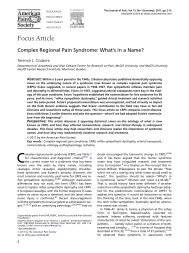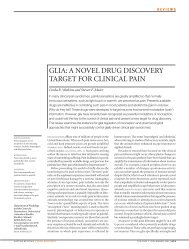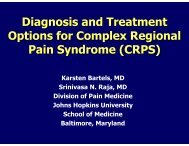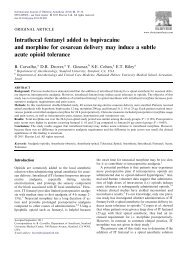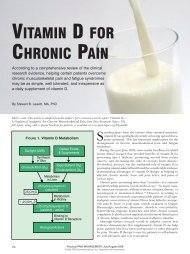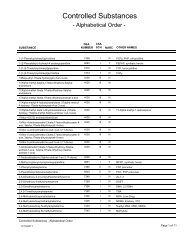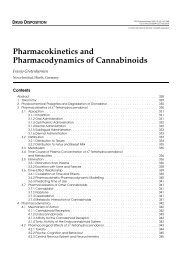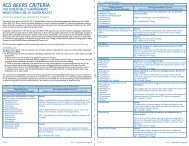1 Introduction to Yamamoto New Scalp Acupuncture ... - Thblack.com
1 Introduction to Yamamoto New Scalp Acupuncture ... - Thblack.com
1 Introduction to Yamamoto New Scalp Acupuncture ... - Thblack.com
- No tags were found...
You also want an ePaper? Increase the reach of your titles
YUMPU automatically turns print PDFs into web optimized ePapers that Google loves.
1“To live in harmony with yin and yang means life:<strong>to</strong> act contrary <strong>to</strong> them means death.” 1“Aspire <strong>to</strong> the principle, behave with virtue, abideby benevolence and immerse yourself in the arts.”–Chinese ProverbWhat is YNSA. A <strong>com</strong>plete acupuncture microsystemof the scalp utilizing Basic (ana<strong>to</strong>mical) andYpsilon (channel) points <strong>to</strong> affect the human bodythrough the bioelectric and biochemical systems,enabling the patient <strong>to</strong> move <strong>to</strong>ward balance andharmony, which is health.<strong>Introduction</strong><strong>to</strong> Yamamo<strong>to</strong><strong>New</strong> <strong>Scalp</strong><strong>Acupuncture</strong>(YNSA)His<strong>to</strong>ry of YNSA. Discovered by Toshikatsu Yamamo<strong>to</strong>,M.D., Ph.D., Miyazaki, Japan, in 1973 andcurrently practiced in Japan, Europe, North America,Brazil, and Australia.YNSA success. Thousands of patients havereceived pain relief and res<strong>to</strong>red health utilizingYNSA for such infirmities as stroke, herniateddiscs, chronic fatigue, fibromyalgia, and migraineheadaches, <strong>to</strong> name a few.
2 1 <strong>Introduction</strong> <strong>to</strong> Yamamo<strong>to</strong> <strong>New</strong> <strong>Scalp</strong> <strong>Acupuncture</strong> (YNSA)While treating patients in his hospital andclinic, Toshikatsu Yamamo<strong>to</strong>, M.D., Ph.D., of Miyazaki,Japan, discovered and developed a new systemof scalp acupuncture, Yamamo<strong>to</strong> <strong>New</strong> <strong>Scalp</strong><strong>Acupuncture</strong> (YNSA). He first presented this systemof scalp acupuncture at Ryodoraku Congressin Osaka, Japan, in 1973. Dr. Yamamo<strong>to</strong> thendeveloped the YNSA system of neck and abdominaldiagnostic procedures coupled with scalp,chest, and pubis microacupuncture treatment.He did this while caring for patients with acuteand chronic neurological pain at Yamamo<strong>to</strong> Hospitalin Nichinan, Japan.OverviewYNSA is a microsystem of acupuncture. Dr. RalphAlan Dale of Miami, Florida, introduced the termmicroacupuncture at the 1974 Third World Symposiumon <strong>Acupuncture</strong> and Chinese Medicine.Dr. Dale defined microacupuncture as the expressionof the entire body’s qi in each major ana<strong>to</strong>micalregion. 2 Microacupuncture systems havebeen identified by Dale on the ear, foot, hand,scalp, face, nose, iris, teeth, <strong>to</strong>ngue, wrist, abdomen,back, and every long bone of the body. Eachregion is a functional microcosm of the traditionalenergies of the whole body. Every part ofthe body contains the representation of an energeticmicroorganism through microacupointsand microchannels that reiterate the <strong>to</strong>pology ofthe body. 3An acupuncture microsystem is defined as a singlepart of the human body that, when accessed,can directly influence the entire body’s qi, blood,and moisture—from the organ <strong>to</strong> the cellular level—resulting in changes of physiology and symp<strong>to</strong>ma<strong>to</strong>logy.4 Every microsystem manifests neurologicalreflexes connected <strong>to</strong> parts of the bodythat are remote from the ana<strong>to</strong>mical location ofthat particular microsystem. These reflexes canbe both diagnostic and therapeutic. They can beactivated by acupuncture needles, massage, moxibustion,heat, electrical stimulation, and magnets.Locations of distant tender points are notrandom but are related <strong>to</strong> the neurological reflexpattern that is centrally mediated. The microsystemreflex map of the body represents the ana<strong>to</strong>micalarrangement of the whole body. Soma<strong>to</strong><strong>to</strong>pemeans representative body area or map. Thesoma<strong>to</strong><strong>to</strong>pe of YNSA is oriented in an upright patternand its representation is ipsilateral, whichmeans same side; that is, if the right shoulderhurts, the YNSA acupoint will be most likely onthe right side of the scalp. Furthermore, there arebidirectional connections in the microsystempoint when pathology is in a specific organ orbody part, which is indicated by changes in theskin conductivity; thus, stimulating that microsystempoint can produce changes in the correspondingparts of the body. Cutaneous stimulationtriggers nervous system messages <strong>to</strong> thespinal cord and brain, activating bioenergeticchanges, biochemical exchanges, and alterationsin the electrical firing of neuronal reflexes.All microacupuncture systems interact withthe macroacupuncture systems; the 12 regular,paired channels, the two single midline channels,and the eight extraordinary vessels. Therefore,the treatment of one system will produce changesin the body’s functional patterns as diagnosed byother systems. Treatment of the overall macro-The MicrosystemsFigure 1–1Yin/yang soma<strong>to</strong><strong>to</strong>pe.
The Microsystems 3Table 1–1The 12 Channels.Organ Point ChannelLungLarge intestineS<strong>to</strong>machSpleenHeartSmall intestineUrinary bladderKidneyPericardiumTriple burnerGall bladderLiverStandardAbbreviationsystem affects the functioning of the microsystems.3 The bioelectrical and biochemical effectsof placing a needle on the scalp will be discussedin Chapter 2. One of the current theories of howthis microsystem of acupuncture may work isexplained in the Fractal Field Model of the structureof the organism, which will be explainedlater in Chapter 2. 4 YNSA is a soma<strong>to</strong><strong>to</strong>pic representativemicrosystem. The entire body is ana<strong>to</strong>micallyand functionally represented on the scalpin an upright manner (Fig. 1–1).YNSA utilizes two types of needling categories:(1) Basic, which correspond with ana<strong>to</strong>micallocations and (2) Ypsilon, which correspond<strong>to</strong> the 12 paired acupuncture channels.The Basic points correspond <strong>to</strong> the axial andappendicular neuromusculoskeletal structures.The Ypsilon points are representative of the 12channels of body acupuncture. The 12 channelsare shown in Table 1–1.To determine the necessity for these Ypsilonpoints, Dr. Yamamo<strong>to</strong> developed a specializedpalpa<strong>to</strong>ry neck diagnostic procedure called YNSAneck diagnosis, which will be discussed in Chapter5.To date, YNSA’s greatest use is in the treatmen<strong>to</strong>f pain and neuromusculoskeletal dysfunctionLULISTSPHTSIBLKIPCTBGBLRand disease. Clinically, YNSA is amenable <strong>to</strong> bothhospital and outpatient settings. Starting withthe patient’s his<strong>to</strong>ry and presenting <strong>com</strong>plaint(s),adding a standard medical physical examination<strong>com</strong>bined with the YNSA neck diagnosis procedure,a skilled practitioner is provided with allthe information needed <strong>to</strong> render a YNSA diagnosisand deliver a high quality YNSA treatment.Utilizing YNSA neck diagnosis <strong>to</strong> determinewhich Basic and Ypsilon points need treatment,one is able <strong>to</strong> be very specific and effective inachieving a balance of qi, blood, and moisture,thereby harmonizing the body’s bioelectric systemwith just a few needles.Traditional Chinese Medicine (TCM) acupunctureis the body acupuncture system consisting ofover 365 acupuncture points (acupoints) strung<strong>to</strong>gether in 14 meridians or channels. TCM is themacrosystem of acupuncture. It is classical, channel-basedacupuncture, where all acupoints aredefined by a channel and correlate with specificacupoint functions, effects, and spirit; some ofthese functions include entry/exit, luo connection,xi cleft, and yuan source. The YNSA microsystemhonors and recognizes the importantfunctions, effects, and spirit of the TCM channelsand their points. YNSA Ypsilon points encapsulateall those points’ actions within the TCM channelin<strong>to</strong> just one acupoint on the scalp. There aremany macroacupuncture or TCM acupoints onthe scalp, including the gall bladder (GB), bladder(BL), triple burner (TB), governing vessel (DU),and s<strong>to</strong>mach (ST). With rare exceptions, YNSApoints are not the same acupoints at all. ThisYNSA system is not a macro or body acupuncturesystem.YNSA is an acupuncture microsystem that isdifferent, yet similar, in some aspects from theother well-known microsystems: Chinese andFrench Auricular, Korean Hand, and Chinese<strong>Scalp</strong> <strong>Acupuncture</strong>. The Chinese and French Auricularsystems are limited <strong>to</strong> the ear for diagnosisand treatment. The Chinese and French auricularsystems are derived from TCM. “The theoreticalorigins of auricular therapy derive in the firstinstance from classical descriptions of the pathwaysof the channels (meridians). Of the twelveprimary channels (meridians), the six yang channelsskirt portions of the ear either directly orthrough a branch channel and the six yin channelshave no direct connections, but are neverthelessindirectly linked through their inner and
4 1 <strong>Introduction</strong> <strong>to</strong> Yamamo<strong>to</strong> <strong>New</strong> <strong>Scalp</strong> <strong>Acupuncture</strong> (YNSA)outer relationships with the yang channel.” 5“More than 200 acupuncture sites were chartedon the auricle by Chinese medical workers.” 3Auricular points are named for their correspondingana<strong>to</strong>mical part, or effect 3 ; these range frompurely ana<strong>to</strong>mical <strong>to</strong> functional <strong>to</strong> psychologicalstates of being. 2 With the use of a device measuringelectrical resistance on the auricle of the ear,research in Europe, America, and Asia has foundthe auricle <strong>to</strong> be diagnostic and therapeutic intreating a variety of diseases. 3Auricular acupuncture (ear acupuncture) hasboth functional and ana<strong>to</strong>mical points. It also hasacupoints that relate <strong>to</strong> the progression of illnessin the four phases, which, when identified duringthe corresponding phase of health (or illness), areamenable <strong>to</strong> effective treatment. Auricular diagnosisoften uses an acupoint finder and treatmentwith electrical stimulation of the point. The latePaul Nogier, M.D., of France, discovered anddeveloped the three soma<strong>to</strong><strong>to</strong>pic phases of illnessprogression in ear acupuncture as described inhis 1981 book, De L’Auriculotherapie a L’Auriculomedicine,which was translated in 1983 <strong>to</strong> FromAuriculotherapy <strong>to</strong> Auriculomedicine. This workdiscusses the three phases, which he defines asec<strong>to</strong>derm, mesoderm, and endoderm; he lateradded the fourth phase, neuromusculoskeletal,on the back of the pinna which largely relates <strong>to</strong>the neuromusculoskeletal system. 6 These fourphases are related <strong>to</strong>, and correspond <strong>to</strong>, the progressionof disease within the human body.Auricular acupuncture is often done using anelectronic detection device that can be both diagnosticand therapeutic. Using Dr. Nogier’s phasesand an electrical device, one is able <strong>to</strong> follow theprogression of reflective changes in the diseasestate as it goes from affecting the superficial <strong>to</strong>internal organ, and from internal organ <strong>to</strong> deeplyaffecting the patient’s mind and finally the spirit.Like Nogier’s auricular acupuncture, YNSA hasfour phases of treatment.● Phase 1 Ec<strong>to</strong>derm treated in Yin of YIN Superficial● Phase 2 Mesoderm treated in Yang of YINOrgan● Phase 3 Endoderm treated in Yin of YANGMind● Phase 4 Neuromusculoskeletal treated in Yangof YANG SpiritFigure 1–2Yangyang of YINYin Yangyin of YINYinLateral four quadrants.yang of YANGyin of YANGThe phases represent the progression of illnessover time and the severity of disease. The Frenchauricular four phases are similar <strong>to</strong> the four YNSAYpsilon quadrants (Yin of YIN, Yang of YIN, Yin ofYANG, and Yang of YANG), as illustrated in Fig.1–2.Korean hand acupuncture is a microsystem ofthe hand only. “As far back as the interclassic, it issuggested that certain diseases can be treated bystimulating the points on the side of the bodyopposite that of the disease.” 7 “This principle ofcontralateral treatment is generally applied <strong>to</strong>hand acupuncture, the disease affecting the leftside of the body is treated by inserting needlesin<strong>to</strong> the right hand and vice versa.” 8 These pointsare named for their ana<strong>to</strong>mical and functionalrelationships. YNSA is different; it treats pointsipsilaterally on the scalp.Although the traditional Chinese <strong>Scalp</strong> <strong>Acupuncture</strong>(CSA) is a microsystem of the scalp likeYNSA, it uses a different soma<strong>to</strong><strong>to</strong>pe than YNSA. 8CSA has been shown <strong>to</strong> be particularly effective intreating strokes and cerebral vascular conditionssimilar <strong>to</strong> Dr. Yamamo<strong>to</strong>’s reports regarding utilizationof YNSA. While there are two scalp microsystemsindicated by Dale in 1976, the principlesystem divides the temporal section of the scalpin<strong>to</strong> three parts. A diagonal line is extended laterallyfrom the <strong>to</strong>p of the head <strong>to</strong> the area of thetemporals above the ear. The lowest portion of
YNSA Diagnosis and Treatment 5this temporal line relates <strong>to</strong> the head. The middlearea relates <strong>to</strong> the body, arms, and hands. Theuppermost region relates <strong>to</strong> the legs and feet. Thisinverted body pattern represented on the scalpactivates reflexes in the ipsilateral cerebral cortex<strong>to</strong> the contralateral side of the body. 9Today, there are five main sects of CSA. Thefirst is Jiao’s Head <strong>Acupuncture</strong>, which is basedon scalp area zones that correspond <strong>to</strong> the functionallocation of the cerebral cortex. It is involvedin more than 40, mainly cerebrogenic, diseases.The second is Fang’s <strong>Scalp</strong> <strong>Acupuncture</strong>, whichis based on superimposing pictures of the spineand the human body in a prone position on thescalp. Its main indication is for cerebrogenic diseasesand eye diseases.The third is Tang’s Head <strong>Acupuncture</strong>, whichis based on the location of the function of the cerebralcortex in <strong>com</strong>bination with the TCM theoryof zang fu organs. The main locations for the acupunctureneedles are the forehead and temporalregions of the scalp that are divided in<strong>to</strong> twoparts—the front (with the supine human bodysuperimposed) and back (with the prone humanbody superimposed)—both of which are dividedin<strong>to</strong> forehead and face zones. There are zones ofupper, middle, and lower jiao, etcetera. The mainindications are wide and varied in addition <strong>to</strong>central nervous system diseases.The fourth is Zhang’s Treatment, which isbased on the location of the acupuncture pointsin certain treatment zones. Manipulation of theacupuncture needle in the scalp is primarily therotational method. The main indications are nervousand mental diseases only.The fifth and last main sect of CSA is Zhu’s<strong>Scalp</strong> <strong>Acupuncture</strong>, which is based on theories ofzang fu organs and channels. The main indicationis hemiplegia due <strong>to</strong> apoplexy. The secondaryindication is <strong>to</strong> treat emergent and severe diseasesof various clinical entities. The internationalstandard plan for the acupoints of scalp acupuncturehas four regions. The forehead region hasfour standard lines. The vertex region has fivestandard lines. The temporal region has two standardlines. Lastly, the occipital region has threestandard lines. Zhu’s <strong>Scalp</strong> <strong>Acupuncture</strong>, in America,is the more popular of the five sects.CSA is concerned with more directly influencingthe brain’s mo<strong>to</strong>r centers by placing stimulatingneedles directly over these centers wherethere are mo<strong>to</strong>r and pre-mo<strong>to</strong>r cortexes. Finally,Drs.Dan Bensky and John O’Connor, in <strong>Acupuncture</strong>:A Comprehensive Text, sum up CSA nicely,saying “generally a principle site is selectedwhich corresponds directly <strong>to</strong> the representativearea on the cerebral cortex for a certain diseaseand a supplementary site may be added which isless directly related.” 10Auricular and hand acupuncture are like YNSAin that they are true microsystems affecting thepatient’s entire body with organ, channel, andbodily function points, albeit needling a differentbody part <strong>to</strong> have an effect. YNSA is differentfrom all other microsystems in that it has an additionalunique palpa<strong>to</strong>ry diagnostic system, YNSANeck Diagnosis, <strong>to</strong> determine which Ypsilon(channel) point is <strong>to</strong> be used. Although TCM(Eight Principles/Five Phases) body macroacupuncturesystems use acupoints on distinct channellines that are connected <strong>to</strong> and go through/around the head, YNSA does not; it has only onepoint per channel in each of the four quadrants.YNSA has a microsystem of Basic Points related <strong>to</strong>kinesic body parts or ana<strong>to</strong>mical sites plus theYpsilon Points, related <strong>to</strong> the 12 channels: lung(LU), large intestine (LI), s<strong>to</strong>mach (ST), spleen(SP), heart (HT), small intestine (SI), bladder (BL),kidney (KI), pericardium (PC), triple burner (TB),gall bladder (GB), and liver (LR). The Basic pointsare usually found in the medial aspect of thescalp, whereas the Ypsilon points are found in thelateral temporal area of the scalp.YNSA Diagnosis and TreatmentYNSA has two main systems for practical diagnosisand treatment: To diagnose, YNSA utilizes his<strong>to</strong>ryand palpation. Palpation means YNSA Neckand/or Abdominal Diagnosis Systems and is usedas the means <strong>to</strong> determine which Basic and/orYpsilon points are tender and thus need acupuncture.For treatment, YNSA places needles in scalpBasic points, which are ana<strong>to</strong>mically related(Figs. 1–3 and 1–4), and/or Ypsilon points, whichare channel related and representative of the 12Primary (zang fu) channels (Fig. 1–5). Basic pointsare determined by his<strong>to</strong>ry, YNSA Neck/AbdominalDiagnosis points, and direct Basic point scalp
6 1 <strong>Introduction</strong> <strong>to</strong> Yamamo<strong>to</strong> <strong>New</strong> <strong>Scalp</strong> <strong>Acupuncture</strong> (YNSA)M.1C.2 A1-7C.1E1-12M.3M.2HB.2B.1S.1 S.4S.2 KS.3 TMJDITable 1–2 Representative Characteristics of Yinand Yang Principle States.YINYANGFemaleMaleSoftHardLowerUpperMoistDryD1-6DarkNightLightDayInteriorColdBloodRetiringExteriorHotQi/energyActiveFigure 1–3Figure 1–4Anterior yin Basic points.KM.3IM.1 HC.2M.2 B.2A1-7S.1B.1S.4 DS.2C.1S.3E1-12Posterior yang Basic points.D1-6palpation for tenderness with palpable subcutaneoustissue elevations in the scalp. Ypsilonpoints are primarily diagnosed by using YNSANeck/Abdominal Diagnosis points followed byYpsilon point palpation for tenderness and/orsubcutaneous tissue elevation in the scalp. Theentire length of each channel is encapsulated inthe respective Ypsilon point.These YNSA Ypsilon and Basic points arefurther divided in<strong>to</strong> two principle states: YIN andYANG. The representative characteristics of eachare given in Table 1–2.YIN, by definition, is the ventral or anteriorhalf of the body and/or lower part of the scalp.YANG, by definition, is the dorsal or posterior halfof the body and/or upper part of the scalp. Each ofthe principle states is further divided in<strong>to</strong> twosubdivisions making up one of the four YNSAquadrants. YIN is further subdivided in<strong>to</strong> Yin ofYIN (Fig. 1–6) and Yang of YIN (Fig. 1–7). YANG isfurther subdivided in<strong>to</strong> Yin of YANG (Fig. 1–8)and Yang of YANG (Fig.1–9).All Basic points are divided in<strong>to</strong> Yin and Yang,which roughly represent the homunculus asdepicted previously in Figure 1–1 and now also inFigure 1–10. The Yin is in the inferior half of thescalp and the Yang is in the superior half of thescalp. Basic points are found in the frontal areaand are called Yin, specifically Yin of YIN. Basicpoints found in the occipital area are called Yang,
YNSA Diagnosis and Treatment 7YangYinLITBSILULUBLSTGBKISP LRPCHTPCHTSISTSPLRKITB GBLIBLGBLRKISPBLSTHTPCHTPCLRSTSPGBSITBLILULITBSILUWernike'sAphasia(right side only)YangBroca'sAphasia(right side only)BLKIFigure 1–5Lateral yin/yang Ypsilon points.specifically Yin of YANG. The head is divided atDu-20 (bai hui), the anterior vertex of the scalp isYang of YIN Basic points and posteriorly <strong>to</strong> Du-20(bai hui), the vertex of the scalp is Yang of YANGbasic point (Fig. 1–11).Ypsilon points also have two principle states:Yin and Yang. Both are present on both the leftand the right side of the head. Within the left andright side of YIN, there is Yin and Yang. Withinthe left and right side of YANG there is Yin andYang. The result is four quadrants on the left andfour quadrants on the right. These four quadrantsof Ypsilon points are Yin of YIN, Yang of YIN, Yinof YANG, and Yang of YANG, either left or right, asseen previously in Figure 1–2. The location of theYpsilon points in the four quadrants correlates
8 1 <strong>Introduction</strong> <strong>to</strong> Yamamo<strong>to</strong> <strong>New</strong> <strong>Scalp</strong> <strong>Acupuncture</strong> (YNSA)YangYin Yangyin of YINYinFigure 1–6Lateral yin of YIN quadrant.YangYin YangYinYangYin Yangyin of YANGYinFigure 1–8Lateral yin of YANG quadrant.yang of YINYangyang of YANGYin YangYinFigure 1–7Lateral yang of YIN quadrant.Figure 1–9█with the four phases of health similar <strong>to</strong> Nogier’sfour phases in auricular acupuncture.Two principle categories of YNSA points are:● Basic points● Ypsilon pointsTwo Sides of Basic and Ypsilon points:● Left● RightTwo Principle states of Basic and Ypsilon points:● Yin● Yang
YNSA and <strong>Acupuncture</strong> Integration 9yin of YINyang of YINyang of YANGIn conclusion, YNSA’s microsystem of acupuncturewas originally developed focusing on thescalp. The Basic points cover regional body parts,including arm, leg, regions of the spine, cerebrum,cerebellum, and specialized points for sciatic,tinnitus, aphasia, and cranial nerves. The Ypsilonpoints directly relate <strong>to</strong> the 12 zang fuacupuncture channels, see Table 1–1, with Ren/conception vessel and Du/governing vessel notyet separately identified. The YNSA Neck andAbdominal Diagnostic System is used <strong>to</strong> identifywhich Ypsilon points require treatment based onpalpa<strong>to</strong>ry tenderness and quadrant.yin of YANGYNSA and <strong>Acupuncture</strong> IntegrationFigure 1–10 Crown soma<strong>to</strong><strong>to</strong>pe Yin and YANG.Figure 1–11 Crown of four quadrants.Four Quadrants of Basic and Ypsilon points:● Yin of YIN● Yang of YIN● Yin of YANG● Yang of YANGYNSA provides both diagnostic and therapeuticacupuncture microsystems designed for relievingboth somatic and visceral problems through themodulation of neurotransmitters, affecting pain,and ultimately by balancing the 12 zang fu acupuncturechannels effecting pernicious influences,in addition <strong>to</strong> qi, blood, and moisturewithin the TCM paradigm. 11With the addition of Five Element/Five Phasesand TCM knowledge, one is able <strong>to</strong> use the Ypsilonpoints more efficiently and effectively <strong>to</strong> harmonizeand balance these 12 channels. Successfultreatment can be clinically verified through thephysiologic feedback loop as demonstrated bylack of tenderness in YNSA neck diagnosis pointsor normalized TCM (Eight Principle/Five Phase)pulse diagnoses after correct placement of YNSAneedles. The pulse diagnostic system immediatelyindicates a more balanced pulse after properneedle placement. The YNSA Neck Diagnosis procedureimproves immediately <strong>to</strong> no tendernessafter correct needle placement. Thus, one is able<strong>to</strong> treat the patient in a <strong>com</strong>plete, holistic,balanced, and harmonic way using YNSA.It is the author’s opinion that any microsystemcannot provide the same exact effect on thehuman body, mind, and spirit as the three mainmacrosystems, TCM, Five Element/Five Phases,and French Energetics. There is no YNSA point <strong>to</strong>represent the spirit of the acupoint, such as KI-24.There are no YNSA points <strong>to</strong> represent the functionof the entry and exit points. There are noYNSA points that exactly represent triangular
10 1 <strong>Introduction</strong> <strong>to</strong> Yamamo<strong>to</strong> <strong>New</strong> <strong>Scalp</strong> <strong>Acupuncture</strong> (YNSA)equilibration with progression. And finally, thereare no YNSA points that are as effective forremoving blocks as Five Phase treatments, suchas Internal and External Dragons. After all, YNSAis a microsystem, a shorthand way <strong>to</strong> get thebody’s attention <strong>to</strong> change and be<strong>com</strong>e balanced,but it cannot <strong>com</strong>pete with all the nuances of themacroacupuncture system’s content of clinicaleffect, spiritual effect, and a single body acupoint’sspecific physiological effect. However, theshorthand microacupuncture system provides aquick, powerful effect with a few needles <strong>to</strong> balanceand harmonize the body’s system anduniquely affect the central nervous system.With this elaborate YNSA microacupuncturesystem, using the knowledge of Five Phase acupunctureand TCM, a practitioner can easily focusthe treatment approach <strong>to</strong> the patient in quite anelegant way, often with only a few well-placedYNSA needles. For example, a patient withasthma might have positive left Yin of YIN KI andLU by YNSA neck diagnosis points. To treat, thepractitioner would simply needle these two leftYin of YIN YNSA Ypsilon points, KI and LU. Then,the practitioner would recheck the YNSA necktenderness and/or Five Phase/TCM pulse diagnosisfor verification of a successful treatment. Withonly two needles, the YNSA practitioner hasaffected tai yin (LU) and shao yin (KI), the motherand the son, the original qi and the source qi.YNSA is most often used as a stand-alonetreatment but may in certain circumstances beused as reinforcement <strong>to</strong> other moderate <strong>to</strong> lightmacroacupuncture treatment approaches. Forexample, in a case with pelvic pain, one may useYNSA Basic point C-2 for the pelvis and the dai moextraordinary channel for treatment of pelvicpain. Another example, in TCM with the diagnosisof deficient blood causing decreased memory in a60-year-old, is using YNSA points M-2, HT, KI,and SP <strong>to</strong> <strong>to</strong>nify blood, in addition <strong>to</strong> the TCMmacroacupuncture sea of blood points, ST-37, ST-39, and BL-11. YNSA also may be quite effectivelyused on the same day with other forms of treatmentsuch as injections, medication, psychotherapy,physical therapy, and manipulation, whichwill be covered more in Chapters 10 and 13.It is by placing all the needles in the correctYpsilon quadrant, over the correct representativechannels, that one can produce a beautiful, electromagneticharmonic wave, thereby affectingthe brain. This bioelectrical and biomechanicaleffect of the needle is transmitted through thefascia and mesodermally derived structures <strong>to</strong>the rest of the body. The end result is balanced qi,blood, and moisture flowing through all channels.This is done through proper placement of needlesusing the YNSA methodology, which effectivelypurges pernicious influences and enlivens theeight principles (e.g., strengthen heart, purgephlegm, and <strong>to</strong>nify moisture, which, in turn,res<strong>to</strong>res joy and fluidity within the patient’sphysiologyand psychology).YNSA UtilizationThis YNSA system is particularly good at helpingtreat pain, neurological conditions, and organdysfunctions. YNSA may be used in a variety ofmedical, surgical, and pain conditions either asprimary treatment or as secondary/<strong>com</strong>plementarytreatment. In all surgical and most medicalcases, it will be <strong>com</strong>plementary and not the primarytreatment because many diseases and medicalconditions have very effective Western medicaltreatment pro<strong>to</strong>cols. The best medical carerequires a skilled physician <strong>to</strong> diagnose and treatusing these medical and surgical procedures <strong>to</strong>alleviate disease, pain, and suffering. But with theadvent of YNSA, one is able <strong>to</strong> very effectively andefficiently provide speedy pain relief while effectivelybalancing out the neurophysiologicalabnormalities present with just a few needlesplaced correctly in the scalp. YNSA utilizationwith thoughtful consideration can be furtherenhanced by the practitioner’s knowledge, skill,and ability in other macroacupuncture systems:TCM, French Energetics, and Five Phase acupuncture.YNSA may be used as the primary treatmentin neurological dysfunctions (i.e., pain, neuralgia,neuropathies, neuritis, and/or somatic dysfunction);however, the best results occur when YNSAis used in conjunction with orthodox medical,osteopathic, and/or chiropractic care. Cases treatedwith YNSA include post-CVA, paralysis, aphasia,cerebral palsy, sciatica, low back pain, herniateddisc pain, spinal radiculopathy, painfulspinal stenosis, tinnitus, arthritic pain, fibromyalgia,and medical conditions such as diabetes mellitus,hypothyroidism, menopause, dysmenor-
Summary 11rhea, and other acute or recurrent painful conditions.QiánSummaryYNSA is a <strong>com</strong>plete microsystem of the scalpusing Basic (ana<strong>to</strong>mical) and Ypsilon (channel)points <strong>to</strong> affect the entire person. ToshikatsuYamamo<strong>to</strong>, MD, PhD, discovered and developedthis system in 1973. Basic and Ypsilon pointsfound in the front of the head are called yin andthe back of the head are called yang. Ypsilonpoints on the lateral side of the head in front ofthe auricle are called yin, and behind the auricleare called yang. Yin and yang are further dividedin<strong>to</strong> Yin of YIN, Yin of YANG, Yang of YIN, andYang of YANG. YNSA is not like traditional CSA inthat YNSA has a different soma<strong>to</strong><strong>to</strong>pe, whereasCSA primarily uses representative areas on thescalp <strong>to</strong> stimulate the cerebral cortex for certaindiseases. As in the auricular microsystem, YNSAhas four phases. These four Ypsilon phases aredefined as Yin of YIN, Yin of YANG, Yang of YIN,and Yang of YANG, which correlate with diseaseprogression. YNSA may be used for a wide varietyof medical and surgical conditions. It is not a substitutefor surgical treatment of many ana<strong>to</strong>micalpathological conditions. It may be used as a primaryor secondary treatment for medical conditions.It has its best utilization in musculoskeletaland neurological conditions of pain and/or dysfunction.YNSA may be used in conjunction withother orthodox, standard medical and surgicaltreatments as a <strong>com</strong>plementary treatment system.The Way of Initiating – Heaven Above,Heaven Below“The way of the Initiating is change andtransformationSo that each being obtains its true natureand destinyAnd the union of great harmony is preserved.This is what is favorable and upright.” 12ReferencesAdditional references are available in Appendix 3. Acupointschema and charts are found in Appendix 1.1. Unschuld PU. Medicine in China: A His<strong>to</strong>ry ofIdeas. Berkeley, CA: University of California Press;1985: 2832. Oleson T. Auriculotherapy Manual: Chinese andWestern Systems of Ear <strong>Acupuncture</strong>. Edinburgh:Churchill Livings<strong>to</strong>ne; 1996: 113. Oleson T. Auriculotherapy Manual: Chinese andWestern Systems of Ear <strong>Acupuncture</strong>. Edinburgh:Churchill Livings<strong>to</strong>ne; 1996: 18–234. Bouevitch V. Microacupuncture systems as fractalsof the human body. The Web-Journal of <strong>Acupuncture</strong>.1996. Available at: http://users.med.auth.gr/∼karanik/english/articles/micros.html.Accessed January 29, 20045. Bensky D, O’Connor J. <strong>Acupuncture</strong>: A ComprehensiveText. Chicago: Eastland Press; 1981: 4726. Oleson T. Auriculotherapy Manual: Chinese andWestern Systems of Ear <strong>Acupuncture</strong>. Edinburgh:Churchill Livings<strong>to</strong>ne; 1996: 165–2707. Bensky D, O’Connor J. <strong>Acupuncture</strong>: A ComprehensiveText. Chicago, IL: Eastland Press; 1981:4738. Bensky D, O’Connor J. <strong>Acupuncture</strong>: A ComprehensiveText. Chicago, IL: Eastland Press; 1981: 5019. Yamamo<strong>to</strong> T, Yamamo<strong>to</strong> H. Yamamo<strong>to</strong> <strong>New</strong> <strong>Scalp</strong><strong>Acupuncture</strong> (YNSA). Tokyo, Japan: Axel SpringerJapan Publishing, Inc.; 1998: 1710. Bensky D, O’Connor J. <strong>Acupuncture</strong>: A ComprehensiveText. Chicago: Eastland Press; 1981:497,49811. Stux G, Pomerantz B. Basics of <strong>Acupuncture</strong>. 5thed. Berlin, Germany: Springer; 1998: 7–2312. Huang A. The Complete I Ching. Rochester, VT:Inner Traditions; 1998: 24



